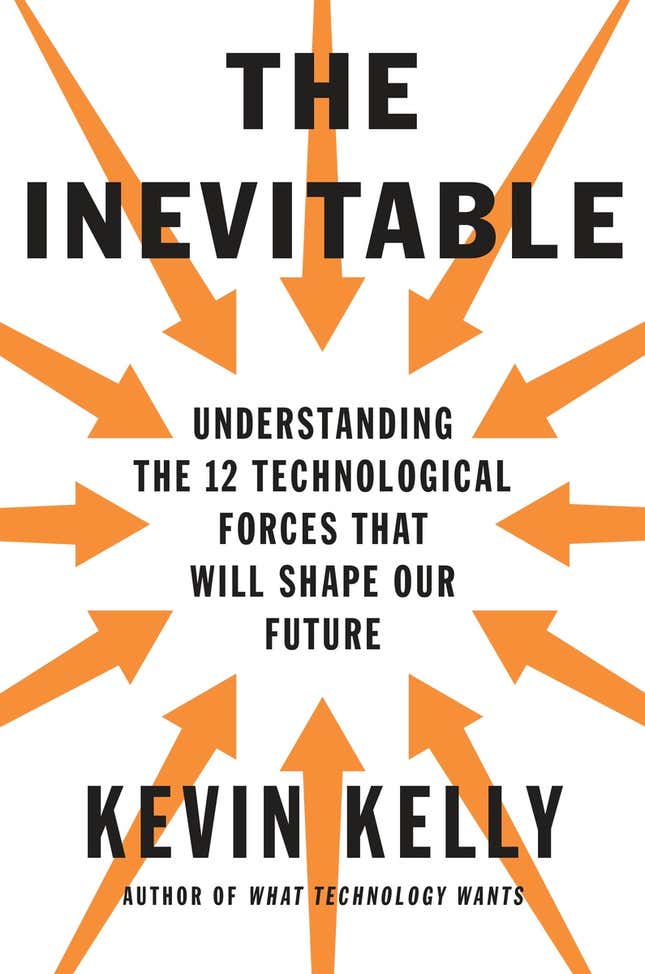After living online for the past three decades, first as a pioneer in a rather wild empty quarter, and then later as a builder who constructed parts of this new continent, my confidence in inevitability is based on the depth of these technological changes. The daily glitter of high-tech novelty rides upon slow currents. The roots of the digital world are anchored in the physical needs and natural tendencies of bits, information, and networks. No matter what geography, no matter what companies, no matter what politics, these fundamental ingredients of bits and networks will hatch similar results again and again. Their inevitability stems from their basic physics. I endeavor to expose these roots of digital technology because from them will issue the enduring trends in the next three decades.
Not all of this shift will be welcomed. Established industries will topple because their old business models no longer work. Entire occupations will disappear, together with some people’s livelihoods. New occupations will be born and they will prosper unequally, causing envy. The continuation and extension of the trends I outline will challenge current legal assumptions and tread on the edge of outlaw—a hurdle for law abiding citizens. By its nature, digital network technology rattles international borders because it is borderless. There will be heartbreak, conflict and confusion.
Our first impulse when we confront extreme technology surging forward in this digital sphere may be to push back. To stop it, prohibit it, deny it, or at least make it hard to use. (As one example, when the internet made it easy to copy music and movies, Hollywood and the music industry did everything they could to stop the copying. To no avail. They only succeeded in making enemies of their customers.) Banning the inevitable usually backfires. Prohibition is at best temporary, and in the long counter productive.
A vigilant eyes-wide-open embrace works much better. My intent is to uncover the roots of digital change so that we can embrace them. Once seen, we can work with their nature, rather than struggle against it. Massive copying is here to stay. Massive tracking and total surveillance is here to stay. Ownership is shifting. Virtual reality is becoming real. We can’t stop artificial intelligences and robots from improving, creating new businesses and taking our current jobs. It may be against our initial impulse, but we should embrace the perpetual remixing of these technologies. Only by working with these technologies, rather than trying to thwart them, can we gain the best of what they have to offer. I don’t mean to keep our hands off. We need to regulate these emerging inventions to prevent actual (vs. hypothetical) harms, both by legal and technological means. We need to civilize and tame them in their particulars. But we can only do that with deep engagement, first-hand experience, and a vigilant acceptance. These technologies are not going away.
Change is inevitable. We now appreciate that everything is mutable and undergoing change, even though much of this alteration is imperceptible. The highest mountains are slowly wearing away under our feet, while every animal and plant species on the planet is morphing into something different in ultra slow motion. Even the eternal shining sun is fading on an astronomical schedule, though we will be long gone when it does. Human culture, and biology, too, are part of this imperceptible slide towards something new.

At the center of every significant change in our lives today is a technology of some sort. Technology is humanity’s accelerant. Because of technology everything we make is always in the process of becoming. Every kind of thing is becoming something else, while it churns from “might” to “is.” All is flux. Nothing is finished. Nothing is done. This never-ending change is the pivotal axis of the modern world.
Constant flux means more than simply “things will be different.” It means processes—the engines of flux—are now more important than products. Our greatest invention in the past 200 years was not a particular gadget or tool but the invention of the scientific process itself. Once we invented the scientific method, we could immediately create thousands of other amazing things we could have never discovered any other way. This methodical process of constant change and improvement was a million times better than inventing any particular product because the process generated a million new products over the centuries since we invented it. Get the ongoing process right and it will keep generating ongoing benefits. In our new era, processes trump products.
This shift towards processes also means ceaseless change is the fate for everything we make. We are moving away from the world of fixed nouns and towards a world of fluid verbs. In the next thirty years we will continue to take solid things—an automobile, a shoe—and turn them into intangible verbs. Products will become services and processes. Embedded with high doses of technology, an automobile becomes a transportation service, a continually updated sequence of materials, rapidly adapting to customer usage, feedback, competition, innovation, and wear. Whether it is a driverless car, or one you drive, this transportation service is packed with flexibility, customization, upgrades, connections, and new benefits. A shoe, too, is no longer a finished product, but an endless process of reimagining our extended feet, perhaps with disposable covers, sandals that morph as you walk, treads that shift, or floors that act as shoes. “Shoe-ing” becomes a service and not a noun. In the intangible digital realm, nothing is static or fixed. Everything is becoming.
Upon this relentless change all the disruptions of modernity ride.
